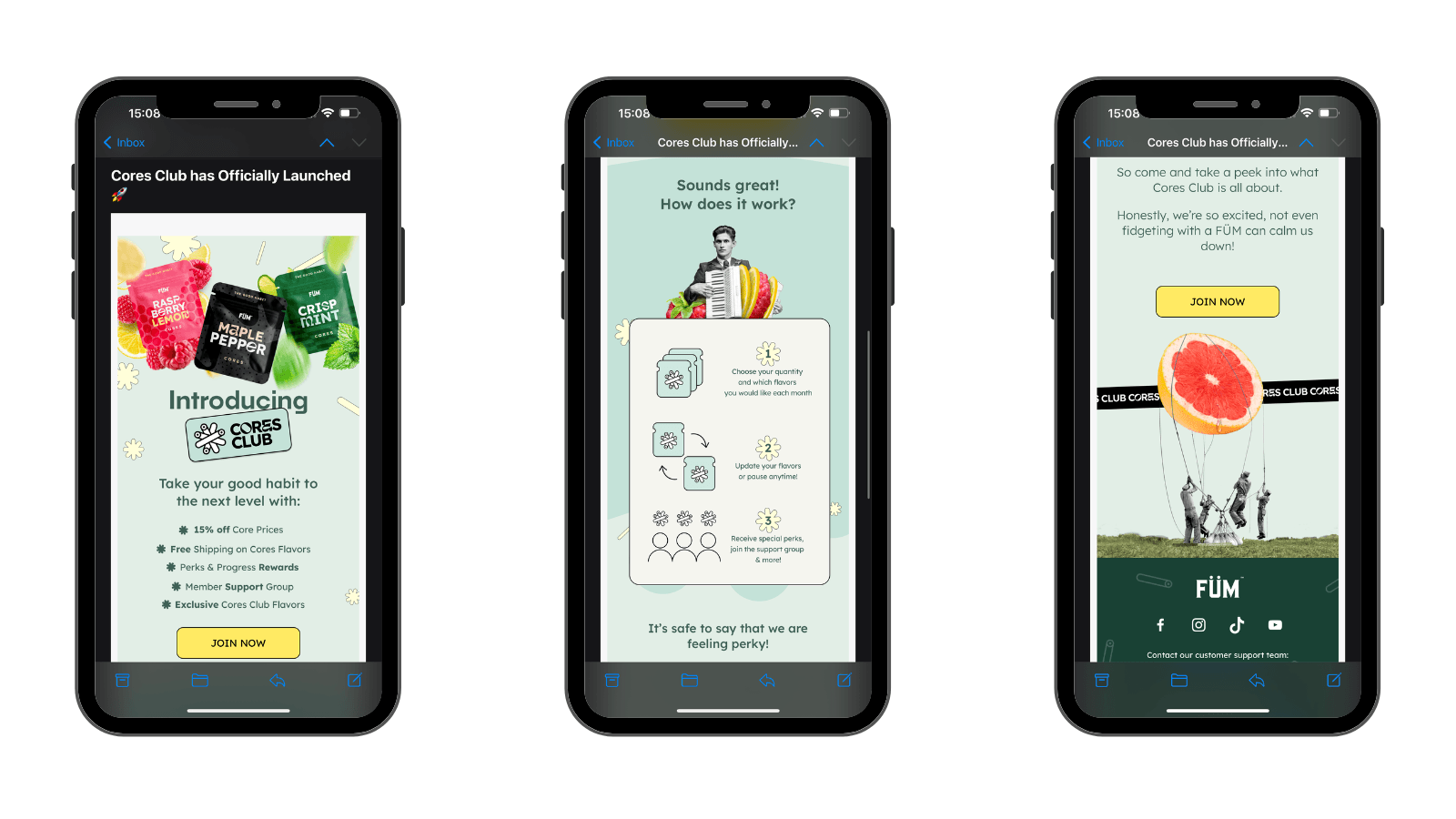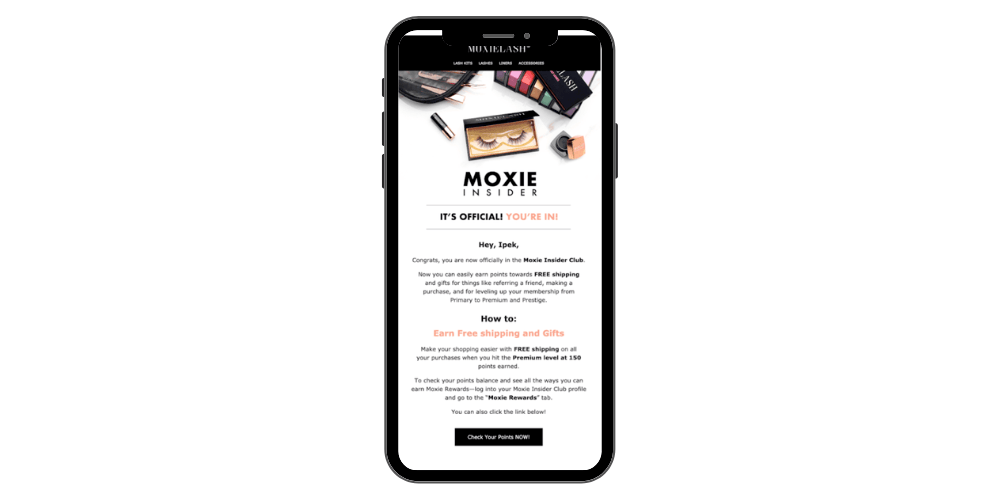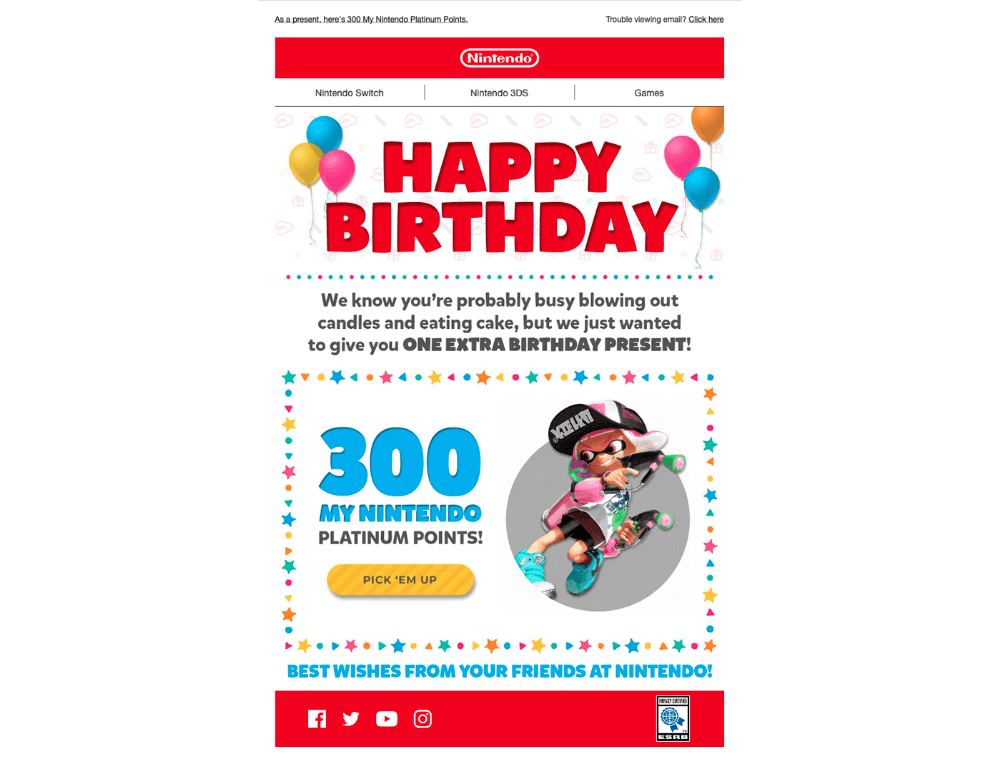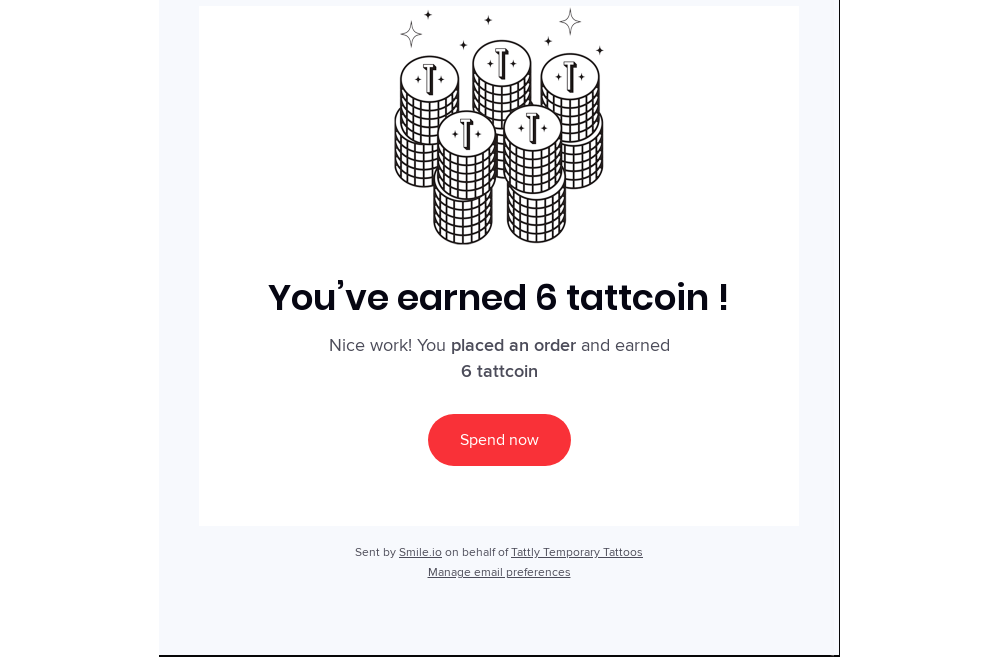Imagine you spent weeks, maybe even months, working on your loyalty program — figuring out the rewards structure, what rewards you can offer, how customers can earn points, the design and copy involved, and of course, launching the program itself.
A couple of months go by, and your program hasn’t performed as well as you hoped. Sure, you could tweak the program, but chances are you haven’t promoted your program well enough, and one of the best channels to help you do that is email marketing.
Using email marketing to promote your loyalty program offers several opportunities, including:
- An overall increase in your email engagement rate
- Increased engagement with your loyalty program
- Higher average order values
- Higher repeat purchase rates
Several LoyaltyLion customers experience these benefits when they use LoyaltyLion and its email service provider (ESP) integrations. However, where there are opportunities there are also challenges, including:
- Knowing how to properly segment your email audience;
- Knowing how to craft your emails in a compelling way; and
- Creating the right email sequence and triggers to maximize opportunities.
On balance, overcoming the challenges of loyalty emails is well worth the effort, and in this guide, we’ll teach you how to do it.
The importance of loyalty program emails
As I mentioned above, there are quite a few benefits that come with using email marketing for your loyalty program. Here are some statistics that show you how loyalty programs help improve your email metrics while also improving loyalty program performance.
Validity’s 2021 Marketer Email Tracker Report suggests the following types of information were the most effective in encouraging consumers to give their email addresses to a brand:
- 39% said “trust in the brand”
- 36% said “discounts and offers”
- 31% said “joining a loyalty program”
These stats give us a business perspective on what information works for marketers to get customers interested in email. On the other hand, Digital Commerce 360’s 2022 report also shares insight on the types of retail/commerce emails that shoppers are most likely to open:
- 40% said “offers regarding loyalty programs”
- 62% said “messages about promotions/discounts currently available”
Going into LoyaltyLion’s customer case studies, we also find a few examples of how promoting loyalty programs via email helps to increase engagement with the programs, including:
- Nuud found that by promoting the program’s referrals, program members started spending 153% more than regular customers.
- The Vape Shop started with loyalty program email triggers right away and within just six weeks saw a 2.7% increase in orders, and a 4% increase in associated revenues.
- Ofra Cosmetics combined loyalty, referrals, and email in their strategy and saw a 59% increase in customer spend and generated over $183k in revenue from this combined strategy.
All of this research suggests that email marketing and loyalty programs benefit each other, so it’s a win-win to use a channel you’re likely already using to promote your program.
Types of loyalty emails you can use
When you think of loyalty program emails, your mind likely thinks of a launch or invitation, “Hey, come join our loyalty program, we have cookies”, type of email. However, there are quite a few different loyalty emails you can use to promote (and maintain) your program.
1. Launch email
A launch email does what it says on the tin — it promotes the launch of your new loyalty program. These emails are extremely important as they’ll likely be the first impression you give customers of your program.
A good tip for getting your launch email right is to do some customer testing on your loyalty program first so that a) you know it works, and b) it’s something that would excite your customers. You’ll feel better with data backing your ideas.
2. Invitation to join
After your launch email, you’ll probably get a decent amount of interest and click-throughs from customers who are interested in finding out more. However, it’s still likely your first launch email slips through some cracks, or you’ve had new customers since the launch.
An invitation to join the loyalty program is, therefore, also an essential part of the loyalty email sequence. However, it is an easy one to implement — you can trigger the invitation when a customer orders a product but doesn’t create an account.
3. Welcome email
The next email in the loyalty sequence is a welcome email. This type of email is particularly important because (at least assuming there are more people like me in the world) customers want acknowledgment when they’ve signed up.
Welcome emails are a great opportunity to thank your new members for joining and give them information that can help them start earning rewards right away.
The key challenge for these emails is to avoid information overload — try not to wax lyrical about the origins of your business.
4. Post-purchase points update
When members purchase products from your store, you can add information about their updated loyalty points (or whichever naming system you use) to their transactional email, or create a separate post-purchase update email.
These emails are important because they can remind your customers about their points balance, and how close they are to earning a reward — which can influence them to make further purchases sooner.
5. Points redemption
When customers earn enough points to get a reward, you can send them a points redemption email to remind them about it (because trust me, people do forget).
There are two ways you can go about these emails. First, you can send them to your loyalty page to look at options, or you can send them a link to redeem a specific reward (i.e. if they’ve only earned one type of reward).
The main challenge with this type of email is the effort and energy you need to tailor the messaging for each type of redemption offer you have (which grows if you use a tiered loyalty program). However, that’s where sending the generic “you’ve got rewards” email can come in handy.
6. Points expiring
Not every brand will opt to have a system where loyalty points expire after a specific period (usually a year or annually on a date). However, if you do, it’s critical to make sure you tell your members when their points are close to expiring.
From personal experience, it’s quite disheartening when you go to your account, only to find all your points have mysteriously disappeared.
In general, it’s a good idea to let new members know in their welcome email that loyalty points expire in the time frame you chose.
7. Monthly updates
Depending on the vertical your store is in, you may have customers who purchase very regularly or only purchase once in a while. Sending these customers regular updates about their points balance has a similar impact as points redemption emails.
Your customers get reminded about their progress toward rewards or what rewards they’re already eligible to redeem, which can influence them to make further purchases.
The challenge with these types of emails is to not make them too regular (hence, “monthly” updates), as well as them being easy to ignore after a while since customers will know they’re coming regularly.
8. One-off rewards
You might decide to offer a one-off promotional reward, special members-only loyalty events, birthday rewards, or compensatory rewards from customer service. Either way, for customers, getting a one-off reward email is most likely to surprise and delight them.
The difficulty with these reward options is keeping track of them, and making sure any redemption codes related to one-off rewards have specific expiry conditions.
9. Invitation to refer friends
Finally, you can use email to help grow your loyalty program by promoting the program’s referral scheme. The obvious benefit to this type of email is the chance of increasing your loyalty member base.
But on the flip side, you need to make the offer compelling enough to motivate customers to go through the effort of referring someone. One of the best ways to do so is to offer a significant points boost that would allow them to redeem at least a small reward right away.
Crafting a compelling email
Now you know why combining email marketing and your loyalty program is the way to go, and the types of emails you can send, let’s take a quick look at what it takes to write them.
For email copywriting, there are two distinct areas to think about — the subject line and the body content.
Email subject lines
- Personalize them wherever you can and whenever is appropriate — address the customer by name, or if for some reason you don’t have their name, use other information like purchase history, loyalty tier status, or their pet’s names (for pet-based brands).
- When appropriate, create a sense of urgency. The obvious candidates here are points expiry emails, one-off rewards, and redemption emails, e.g., “You’ve got 48 hours, use ’em or lose ’em.”
- Highlight the benefits or the offer clearly, e.g., “You’ve earned a $10 discount on your next purchase.”
- Keep it short and simple since a lot of people read email on their phones — aim for around 6–10 words.
- Test different styles. You might have an idea of what creates action from your audience, but you don’t know for sure until you experiment.
Email body copy
Some of the above tips also work for the email body (e.g., urgency, personalization, and highlighting the benefits), but there are some other tips you can use for the larger content area:
- Keep it concise. While you don’t necessarily need to keep to a strict word count, you still want to make the email scannable.
- Use high-quality, relevant visuals such as product photography and well-designed graphics that bring attention to specific parts of your email body.
- Refer to your brand guidelines. Brand guidelines aren’t just for website and socials (i.e., public communications), your brand needs to be consistent across all channels, including email.
- Use a clear call to action. There’s no point in sending the email if you don’t want your customer to do something after reading it. Use action-oriented words like “claim”, “shop”, and “visit”, that indicate what you want them to do when they see the email.
Carefully segment your audience to optimize performance
Another factor that has a big impact on the effectiveness of email is segmentation. When speaking to Kate Ross of Irresistible Me, she said this is one area ecommerce store owners typically get wrong:
“One common mistake ecommerce store owners make is failing to segment their email lists properly. Sending the same generic message to all customers can lead to disengagement and a lack of interest in the loyalty program.”
Some of the common ways you could segment your loyalty emails include:
- Segments based on loyalty-tier status (this one is critical if you have rewards that are tier-specific, such as VIP exclusive content/events).
- Segments based on points balance, e.g., sending customers with low balances targeted emails that help them earn more points, and reminders to use points for those with a high balance.
- Segments based on activity, for example, frequent shoppers or reward redeemers and customers who are at risk of churning (tip from Kate).
- Segments based on cohort, e.g., new customers/members, members between 6–12 months, and +12 months.
- Segments based on lifestyle/product preferences, which is a general approach to email marketing, but you can boost and refine the categories with loyalty program data (tip from Kate).
The results will speak for themselves when you implement proper segmentation, just as Kate found:
“One of our campaigns, which targeted frequent buyers with early access to new products and special discounts, resulted in a 30% increase in loyalty program participation within just a few months.”
Sending your campaigns at the right time can make a big difference
I touched on this topic sparingly in the section above on the types of email you can use — but knowing your email triggers and send times is also critical for smooth email campaigns.
There are some email sequences that you’ll want to send immediately based on particular triggers, for example:
- You should have welcome emails sent immediately (or within a few minutes) when a customer signs up for the loyalty program.
- Sending a post-purchase points update should also happen very quickly after a purchase-based trigger.
- Some one-off rewards should also have a very quick send time based on triggers such as customer support compensation or time-sensitive promotional events.
- When a customer earns points that take them up to a new reward threshold, they should get an email as soon as possible to let them know about the rewards they can claim.
However, most other types of loyalty emails use time-based triggers, such as:
- Monthly update emails that trigger each month based on the day the customer signed up.
- Points expiry emails based on the defined period you set up for the expiration (e.g., a year from the signup date or on a specific date each year).
- Birthday reward emails based on the customer’s birthdays.
Other types of emails, such as referral invitations and different types of one-off rewards or promotional events are a little trickier and can take some experimentation to find the right times for your audience.
The key is tracking and measurement. Build a regular report that shows email open rate, click-through rate, and conversion rate, and compare these metrics across the different send times. From there, you’ll be able to see when your customers are most engaged with your emails and optimize future campaigns based on the data.
Examples of loyalty emails
It can be difficult to visualize what a good loyalty email looks like, but we won’t keep you in suspense any longer. Let’s take a look at some examples of loyalty emails that we think are the jam.
Füm Cores Club

Füm gives us a great example of a loyalty program launch email — in this case, it’s called the Cores Club. The design itself is attractive with clear product photography as the hero image and a logo design specifically for the program. The email copy introduces the benefits right away, and there’s a clear CTA before explaining how the program works.
MoxieLash

From MoxieLash, we have an excellent example of a program welcome email. The Moxie Insider email gives us a sense of exclusivity (“You’re In!”) and the design of the email itself is simple and easy to read.
What gives this email extra points is the action-oriented copy that explicitly tells the customer how to earn more points (to get free shipping) and to check their current balance.
Paire

In this case, we’ve got another launch email blended with an invitation to join (as most launch emails are). Unlike the other emails we’ve seen so far, Paire uses much larger photography as its hero image which is more akin to a lifestyle appeal (as opposed to straight product photography).
We like this email because it specifically thanks the customer for their previous support before asking them to join and explaining how the program works. This kind of setup would be a great choice for any luxury/lifestyle-focused brand.
Nintendo

The only super multinational example on this list, Nintendo is a fairly unique example because its loyalty program lets you earn points not just for physical purchases, but also for in-app and digital purchases.
That being said, this email clearly caters well to Nintendo’s audience as an example of a one-off reward for the customer’s birthday. The email copy is simple with a clear, gaming-style CTA button.
FSA Store

Moving over to the health niche, the FSA store sells health and wellness-related products aimed at simplifying the US tax-free healthcare market. In this email, we have an example of a monthly points update.
In this case, the recipient doesn’t have any points. As such, the design and copy of the email encourage the customer to start shopping and give suggestions of where to start, as well as give them a button to find out more about how to earn points and what those points will get them.
ON THAT ASS

We get a great example of a loyalty program referral email from ON THAT ASS (yes, that is the brand’s name). The OTA loyalty program is interesting as you get credit towards a member’s exclusive loyalty store (as opposed to discounts or other rewards).
In this email specifically, OTA shows the benefit “Give €10. Get €10.” It then explains, quickly and simply, how the referral program works and gives us a peek at the loyalty webshop with photography of a model wearing an exclusive product.
Tattly

This final email is an example of a post-purchase points update from Tattly (a temporary tattoo store). I personally love this email because I’m more of a minimalist, and the lack of fancy design and copy appeals to me.
However, from a business perspective, not having a lot of elements to the email really makes the “Spend now” button stand out against the white background and black lines.
Sometimes, less is more.
How to measure the success of your loyalty program emails
We also spoke to Roman Zrazhevskiy, Founder and CEO of MIRA Safety for this guide, and while he had very similar tips as Kate did earlier, he also included his steps for using email marketing to promote MIRA Safety’s loyalty program, which were:
- Segment the email list
- Personalize email content
- Design engaging emails
- Automate your campaigns
- Analyze and optimize
On this last point, he points out the importance of measuring specific metrics:
“Regularly analyze email campaign performance using metrics like open rates, click-through rates, and conversions. Track the effectiveness of emails promoting the loyalty program and adjust strategies based on what drives the most engagement and conversions.”
But can we dig a little deeper? Yes. Other than open rates and click-through rates, another classic email metric to keep an eye on is deliverability rates — which tells you how many of your customers are receiving your emails. A lower rate means your emails are getting blocked by the customer’s internet service provider (ISP) or routed to spam folders.
You can improve your deliverability rate by making your emails as relevant and engaging as possible (which can encourage customers to mark emails as “not spam”).
Otherwise, there are also loyalty-specific metrics you can measure, such as:
- Sign-up rates — which is a conversion-based metric you’ll want to measure from program launch and invitation-to-join emails.
- Redemption rates — which you can measure by linking attribution from monthly update emails, one-off offers, and point expiry emails.
- Referral rates — which, similarly to the above, you can measure by linking attribution from referral emails (as opposed to social media links).
- Comparative metrics — these can give you a lot of insight into the performance of email versus other channels, such as “average order value for customers receiving program emails vs those that don’t receive emails”, or “average purchase frequency from customers receiving program emails vs customers who follow the brand on social media.”
To help you measure and track these kinds of metrics, you can use your loyalty program software, such as LoyaltyLion’s loyalty analytics and customer snapshot features. However, combined with an email service provider (ESP) integration (such as LoyaltyLion x Klaviyo), you’ll have all the measurement capabilities you need.
Test your emails to optimize performance
Before we close out this guide, it’s also worth briefly covering testing methods — especially since I mentioned experimentation a few times in this guide. So, how do you go about testing your emails for optimization?
There are primarily two ways to go about it: pre-send testing and A/B testing.
Pre-Send
Before you ever send your business emails, it’s important to have a step before publishing that helps you preview the email design, copy, and technical elements.
Firstly, you can use usability/design testing software such as Lyssna, Maze, and UserTesting to build tests for design and copy to see if your branding and messaging fit with your target audience and get feedback.
In using this approach as part of MIRA Safety’s “Analyze and Optimize” step, Roman saw huge benefits for their loyalty program:
“It’s also a good practice to regularly survey your customers to gather feedback on your loyalty program and adjust it based on their preferences and needs. At MIRA Safety, we found that incorporating customer feedback into our program led to a 25% increase in active loyalty members, as customers felt more valued and engaged.”
You won’t need to do this for every email campaign, but it helps if you’re developing templates.
Secondly, for each email campaign, you do want to make sure that the email is responsive — i.e., that it appears how you want it to across devices. You can do this by sending a test email to a dummy account, or with specialized software.
A/B testing
The most common approach to testing emails is to use the A/B testing method. This method means you have two versions of an email campaign (sent to different customers, not the same ones) to see which of the emails perform better based on the copy and design.
Many ESPs, such as Klaviyo will offer A/B testing as a feature to help you test different subject lines, email content, and send times, and offer analytics that will help you optimize future campaigns based on the better-performing emails.
How loyalty program email software can help
At this point, you should have a strong understanding of how beneficial email marketing can be to promote your store’s loyalty program, as well as have several ideas for using this approach moving forward.
The best method for achieving great results for your loyalty program from email is to use a loyalty program provider like LoyaltyLion that has solid ESP integrations built into the software.
LoyaltyLion’s ESP integrations include:
- Klaviyo
- HubSpot
- Dotdigital
- Mailchimp
- Omnisend
- Optimizely
- RedEye
Each one of these ESPs has pros and cons (that’s for another guide), but whichever you currently use, combining the functions with your loyalty program data will get you well on the way to having a successful loyalty program.If you’re ready to power up your store with a combined loyalty program and email marketing strategy, check out LoyaltyLion’s pricing page to find a plan to suit your business.





